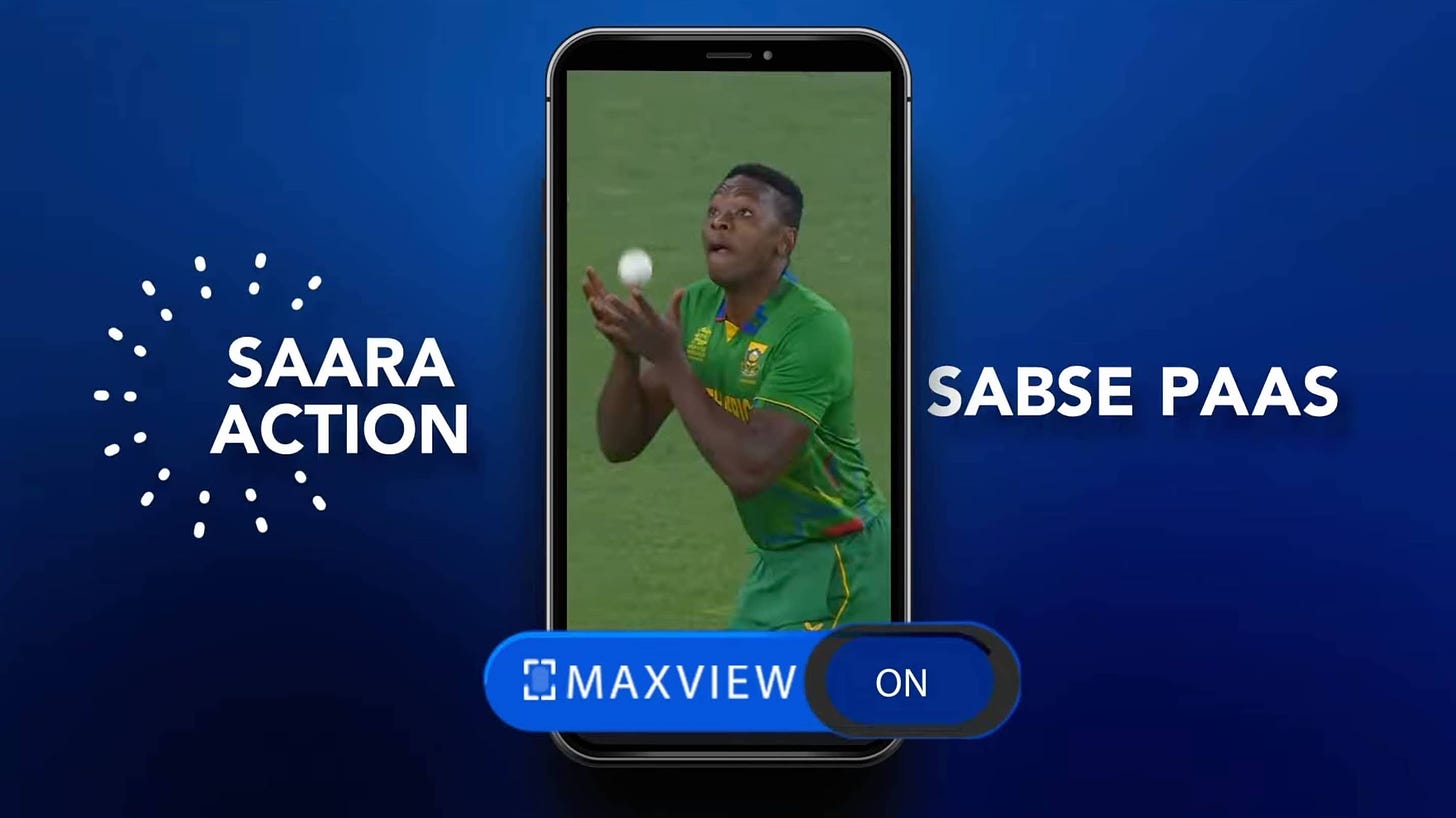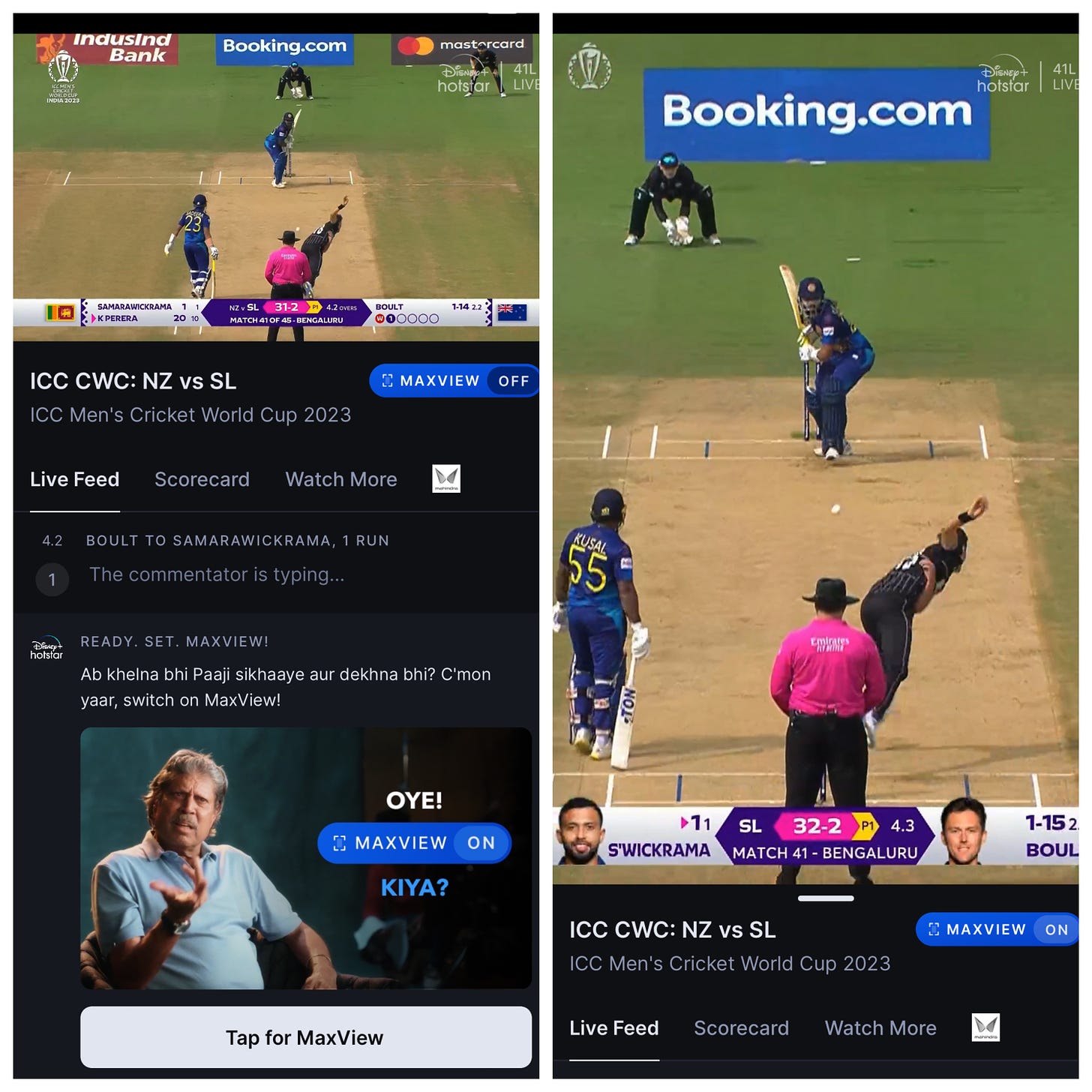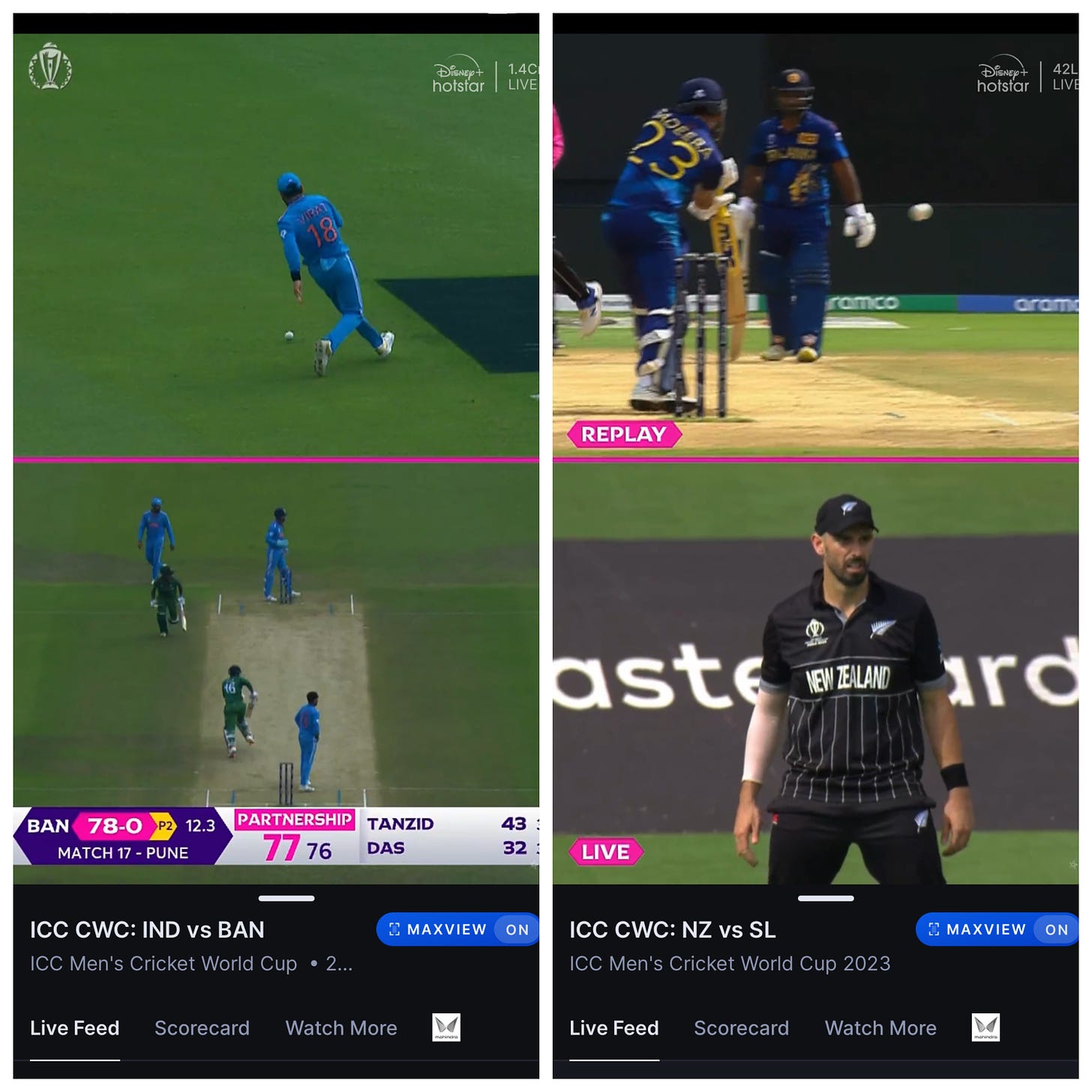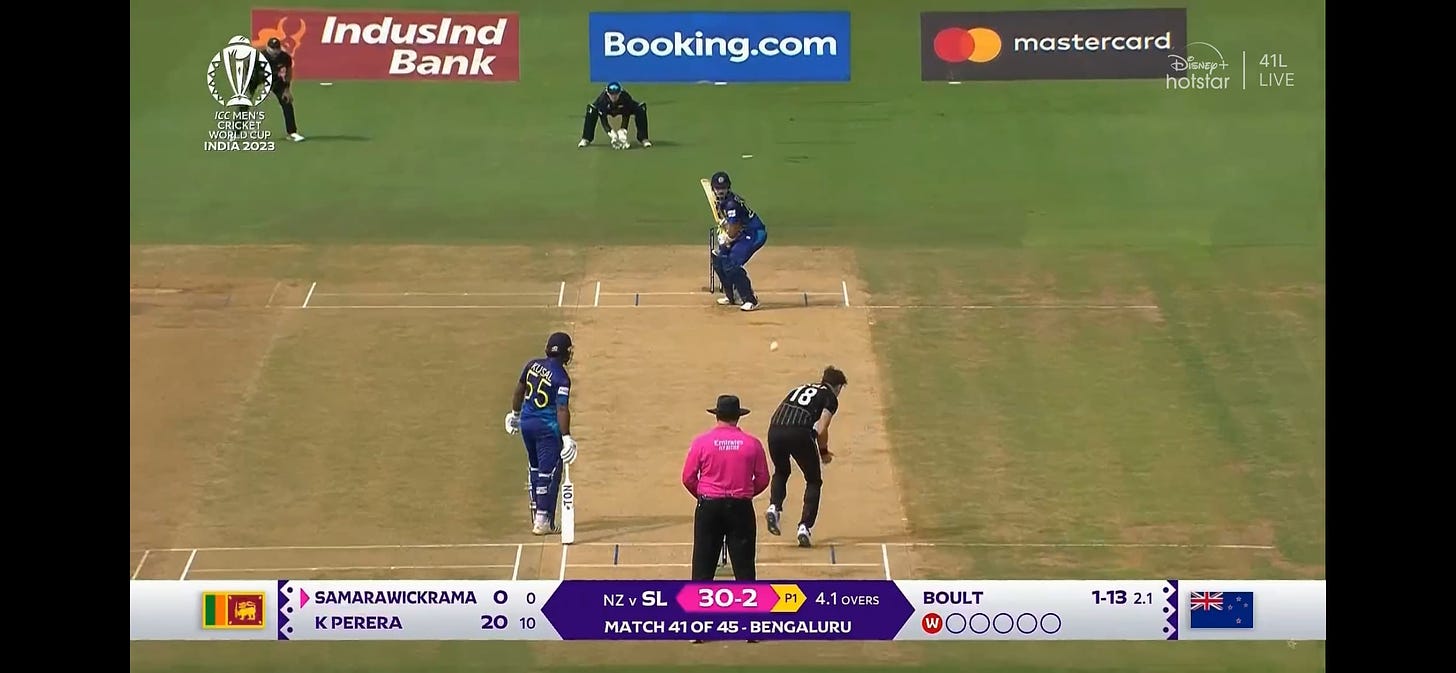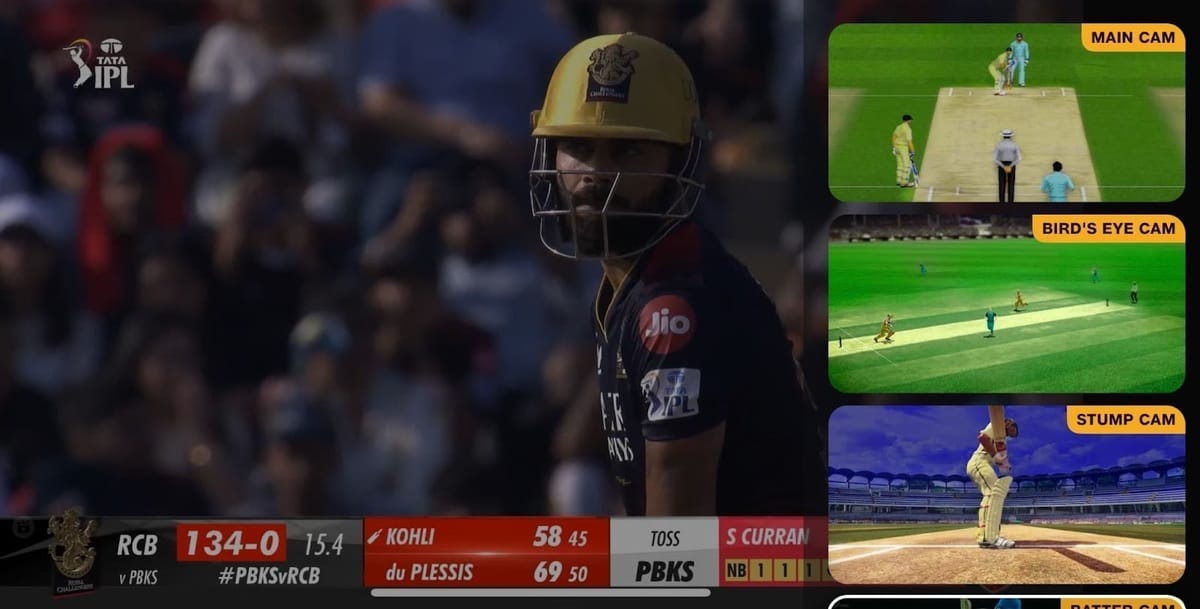Can cricket become a vertical video sport?
Disney+ Hotstar is the latest broadcaster to experiment with vertical video streaming of sports with its new feature, MaxView.
Good evening!
Welcome to The Playbook, a weekly newsletter on the business of sports and gaming. If someone shared this newsletter with you or if you’ve found the online version, please hit the subscribe button below — it’s free! You can unsubscribe anytime.
Thanks to everyone who took The Playbook’s annual reader survey. If you’ve missed it, here’s the link.
We’ve reached the business end of the men’s cricket World Cup. India, South Africa, and Australia are through to the semifinals. New Zealand is most likely to join them in the last four, unless Pakistan or Afghanistan go batshit crazy in their final league match. After a rather damp squib first half, with one-sided matches galore, the World Cup is finally sputtering to life as we enter the final week. I still can’t believe Glenn Maxwell did what he did that day!
One-sided matches or not, Disney+ Hotstar is having a great World Cup. The streaming platform has broken the record for concurrent viewership of a cricket match three times already during the tournament. The latest record is 44 million, set during the India-South Africa match, which the hosts won by 243 runs. Turns out Indians don’t care how competitive a cricket match is, as long as it’s free to watch.
Apart from free mobile streaming, Disney+ Hotstar has also introduced a new way to watch cricket on your phones during this World Cup. It has the potential to revolutionise mobile cricket streaming. At least that’s what Disney+ Hotstar believes.
The TikTokification of live sport
Imagine this scenario: you’re sitting in a train on your way home from work. There’s 20 minutes to go before your stop arrives. You decide to check the score; you open your streaming app and start watching. Five minutes in, your partner messages you to remind you to pay the rent. You switch over to your payments app, pay the rent, and head back to the match. Then, you get a call from your boss asking you to check and reply to an email. Cursing them, you do that, and head back to the game. While switching apps, you see your phone wallpaper and remember you had to buy cat food. You quickly head over to an e-commerce app and do that, before heading back to the match. Before you know it, your stop arrives.
Normally, such a scenario would involve rotating your phone from landscape to portrait mode multiple times, as you switch from watching a match to doing stuff on other apps. Disney+ Hotstar has made this activity easier for your hands with MaxView, its new vertical video streaming feature introduced for the World Cup.
Created in collaboration with the International Cricket Council (ICC), MaxView allows users to watch matches in portrait mode with a 9:14 aspect ratio. This essentially means the video covers about three-fourths of your mobile screen when held vertically. In the traditional mobile streaming method, a full-screen view is available only when the phone is held in landscape mode. If you switch to portrait mode, the landscape 16:9 ratio video is made to fit a vertical screen and is quite small in size.
I know what you’re thinking: how can you watch cricket on a vertical screen? Even if you stretch the portrait mode video to fill most of the vertical screen, cricket has an expansive field of play unlike, say, badminton or tennis, which would be more suitable for vertical video.
Disney+ Hotstar has tried to solve this problem with a split-screen feature in MaxView. Once the batter hits the ball, the screen splits into two: the top half has a camera that follows the ball, while the bottom half focuses on the pitch. It’s kind of a throwback to the ’90s when cricket broadcasts used to have a small picture-in-picture window showing the batters running between the wickets while the main camera followed the ball. The split screen is also used to show replays
What we’re seeing with MaxView is essentially the TikTok-ification—or Reels-ification, if you’re in India—of live sport. Over the last three to four years, there have been various experiments in other sports with vertical video, as rights holders and broadcasters try to tap into the popularity of vertical videos on social media apps such as TikTok, Instagram, and YouTube.
The German football league has been testing vertical video streaming since 2019. In 2021, the Super Cup match between Borussia Dortmund and Bayern Munich was streamed in the vertical 9:16 format for the first time. Sky Sports Germany also tried out vertical video during a Super Cup match earlier this year in collaboration with TikTok. And last year, the NBA released a redesigned app that has a lot of the features you see on TikTok and Instagram, including vertical video clips and highlights.
Vertical video had never been tried for cricket before. Disney+ Hotstar tested the feature with a limited set of users during the Asia Cup in August-September, before launching it officially for the World Cup. It was a giant leap of faith, but one that the company felt it needed to take.
“It is naturally intuitive to hold your phone in a vertical position,” Sajith Sivanandan, head, Disney+ Hotstar, India told The Playbook in an email interaction. “And increasingly, with different forms of video moving to vertical formats, it made sense for us to ensure we found ways to serve our users in the same way by giving them the choice to view the ICC Men’s Cricket World Cup 2023 in either vertical or horizontal mode.”
The MaxView feed is produced by the ICC, while Disney+ Hotstar delivers it to users using its technology. The production blends existing broadcast cameras with dedicated vertically-oriented cameras, Sivanandan said. “To realise MaxView, we’ve strategically positioned six extra cameras at each venue, implementing an independent end-to-end production workflow.”
MaxView also needed a completely different technical setup to adapt the game to a vertical screen. From special and differentiated graphics, including an abridged form of the scorecard at the bottom of the screen, every part of the game had to be customised for vertical video. There is also a separate commentary feed for MaxView, since the visuals don’t always match with the main broadcast feed, especially in the split-screen view.
MaxView is also designed in a way that it supports all mobile devices regardless of screen size. The standard vertical screen aspect ratio is 9:16, but Disney+ Hotstar modified it to 9:14 to ensure compatibility with a wide range of mobile screens.
“Right from the beginning, we adopted a scientific approach by studying viewer behaviour to redesign our graphics effectively, resulting in a seamless vertical viewing experience that captivates our audience. What you see today is the result of hours and hours of designing, recalibrating and redesigning, until we ended up with a feature we knew would excite our viewers.”
Sajith Sivanandan, head, Disney+ Hotstar, India
Sivanandan believes that MaxView has the potential to revolutionise how audiences consume sports. Its success, however, depends on whether users consider it as a need-to-have feature or a good-to-have. I spoke to a few cricket fans who have used the feature, and the overarching feedback I got is that MaxView is a good option to have when you’re watching cricket while also being engaged in other activities. But if you’ve got time to sit back and watch the game uninterrupted, the landscape view is always the preferred option
“If I am travelling, waiting for someone, or expecting a call soon and I want to see what’s happening in the match, MaxView is very helpful,” says Prateek Hegde, a 35-year-old orthopaedic surgeon from Mumbai. “But if I am watching for longer, say an innings, then I switch to the landscape mode. I prefer landscape when I have more time because the area of view is larger, but MaxView is a good option to have.”
Vikas Prasad, a 31-year-old product marketer at Flipkart, concurs, saying he primarily uses MaxView when he’s working or doing something else apart from watching the game. “With MaxView, I can move to other screens or apps in one motion. In landscape mode, it’s a hassle because you need to change your hand position as well. I can’t type using landscape mode and I usually keep the auto-rotate feature off on my phone. But if I have nothing else to do, I always use the landscape mode to watch games.”
MaxView is the second major streaming innovation that Indian sports fans have been offered in the past year. During the 2022 Fifa World Cup, JioCinema introduced a multi-camera feature, which allowed users to pick and choose various camera angles to watch the games. This feature was made available for the 2023 Indian Premier League (IPL) as well. However, as I’ve written in a previous edition of The Playbook, multicam lost its novelty factor pretty soon.
Prasad says he barely used multicam because he never felt the need for it. “I tried it a couple of times, but that was about it. I trust the broadcast director’s discretion to pick the right camera angles. It was too much of a hassle to keep switching the angles yourself. I found myself going back to the default feed.”
Prasad adds that MaxView is a more useful feature to have because it isn’t changing anything apart from the viewing area on the screen. However, he’s unsure whether it’s a need-to-have or good-to-have feature. “It’s just one tournament old. If they make it available for future tournaments, people will get more used to it. It could become a need-to-have in the future.”
Disney+ Hotstar hasn’t revealed whether it plans to make MaxView available for future tournaments. Considering it’s a collaboration with the ICC, we could see it again during the 2024 World T20 next year. It will be interesting to see if JioCinema introduces a vertical video feature for its Indian cricket properties, including the IPL. However, it will be a more expensive feature to introduce compared with multicam, which didn’t have any major additional production costs such as extra cameras.
One way vertical video could be a game-changer for cricket streaming is in the monetisation space. While cricket as a sport doesn’t quite lend itself to vertical video, ads do. If you click on the call-to-action button of an ad while watching a game in landscape mode, which will then take you to the page of the brand, you’ll prefer to switch to portrait mode to continue browsing. With vertical video streaming, this interaction becomes a lot more seamless. Brands can also create engaging vertical ads to connect with consumers more effectively.
Sivanandan says that while creating MaxView, Disney+ Hotstar’s top priority was to provide a smooth vertical viewing experience for its users. But the company also recognised this was a great opportunity to further leverage MaxView for advertisers.
“In fact, the ICC Men’s Cricket World Cup 2023 has seen the use of advertisements specifically made for vertical viewing. Some of the advertisers who have embraced vertical video formats include Hero Vida, Mahindra Swaraj, Mahindra XUV, Airtel, and Godigit. They have leveraged mid-roll videos in vertical format, targeting the same audience as traditional mid-roll video ads. This introduction of vertical ads at such a large scale during live cricket events marks an industry first in India.”
Sajith Sivanandan, head, Disney+ Hotstar, India
While Sivanandan didn’t reveal any figures, a Disney+ Hotstar executive who spoke to me on the condition of anonymity said that the CPM of vertical ads is 1.5x that of regular ads. CPM or cost per mille is the amount an advertiser pays per thousand views of an ad. This is why Disney+ Hotstar first optimised its platform for vertical ads before introducing vertical video streaming.
The success of MaxView or vertical video streaming of sports depends on how well broadcasters can monetise the feature, especially if they’re offering free mobile streaming. It helps that India is a mobile-first market with 700 million-plus smartphone users. But whether broadcasters can get those users to click on an ad while watching sports is what will decide whether vertical video is the future of sports streaming.
⚡️Quick Singles
🏏🏆 The 2025 ICC Champions Trophy, scheduled to be hosted by Pakistan, could become a T20 event. The Guardian reported that broadcaster Disney Star, which paid $3 billion for the media rights of ICC events from 2024 to 2027, is pushing for the change in format since T20 is where the maximum eyeballs are. Seems odd, especially since Disney’s streaming platform Hotstar broke the concurrent viewership record for cricket three times in a 50-over tournament.
🐭🏀 Meanwhile, Disney chief Bob Iger said the company is talking to “a number of different entities” regarding an equity partnership for its ESPN sports network. Disney, which owns 80% of ESPN, is looking to transform the network into a fully direct-to-consumer platform. Iger also told investors during the company’s fourth-quarter earnings call earlier this week that Disney will focus on four building blocks for its future growth: streaming, theme parks and cruises, studios, and ESPN.
⚽️🇺🇸 The National Women’s Soccer League (NWSL) in the US has signed a new four-year media rights deal worth $240 million, a 40x jump from the previous agreement. The matches will be broadcast on Paramount’s CBS, Disney’s ESPN and ABC, Amazon Prime Video, and Scripps Sports. The size of the new deal reflects the growing interest in women’s sports in the US. The WNBA’s current media rights deal, which expires in 2025, is worth anywhere between $13 million and $33 million per year, according to Forbes.
👟💰 Adidas earned around €350 million ($374 million) from selling Yeezy shoes in the quarter ended September 2023. This took the total sales from the Yeezy brand to $800 million since the sportswear major ended its collaboration with controversial rapper Ye (formerly Kanye West) last year. Overall, Adidas’ profits shrunk 27.5% year-on-year to $438 million, largely due to the Yeezy saga. The company’s revenue was down 6% to $6.41 billion.
🎮🇯🇵 Nintendo has sold 4.3 million copies of Super Mario Bros. Wonder within two weeks of its October 20 launch. That’s the best performance ever by a Super Mario game, which could have a lot to do with the phenomenal success of The Super Mario Bros. Movie. Nintendo recently reported that it sold 6.84 million Switch consoles in the first six months of the financial year ending March 2024, a slight bump from the same period last year.
📖 Weekend Reading
Adidas Sambas Became This Year’s Unlikely Hit Sneaker [The Wall Street Journal]
Jim Ratcliffe, Manchester United and the myth of the spotless billionaire [The Guardian]
The Middle East’s play to rule global sports [The Washington Post]
That’s all for this week. If you enjoyed reading The Playbook, please share it with your friends, family, and colleagues. Please also subscribe to it (for free) if you haven’t already.
You can reach out to me at jaideep@thesignal.co with any feedback (good, bad, or ugly), tips, and ideas. I'd love to hear from you!
Thanks for reading, and see you again next Friday!





